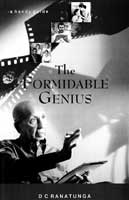
| Well deserved applause from faithful scribe The Formidable Genius - A tribute to Master-filmmaker Lester James Peries on his 87th birthday: April 2, 2006, by D.C. Ranatunga. Sarasavi Publishers, Nugegoda. Reviewed by Neville Weereratne A quiet revolution took place in 1943 in Sri Lanka that should have started a renaissance – and it did to a point even if it did not encompass the whole island and influence its entire civilisation. The 1943 event I refer to was the formation of
the ’43 Group' made up of nine Sri Lankan painters under the
patronage of Lionel Wendt. As a movement in painting, it scored
great success over the decades, both locally and in the judgment
of western criticism.
There was, however, a tenth member of the ’43 Group but he was not a painter. He shared the views of his brother, Ivan Peries, and was totally committed to the aspirations of the Group. He was Lester James Peries who was to become a master of another art form: cinema. He has been hailed widely in Sri Lanka and abroad as an innovative film director who took a fresh approach to the art, paying heed to the culture and genius of the people of Sri Lanka. This is a position that has very much to do with LJP’s membership of the ’43 Group. It was a movement which set out to recognise, establish and maintain an appreciation of the life and landscape of the island that had suffered centuries of scorn, neglect and exploitation. Two other events need to be recalled in this context: J. Vijayatunga wrote ‘Grass for My Feet’ in 1935 and Martin Wickremasinghe wrote ‘Gamperaliya’ in 1944. Vijayatunga’s appeal was to the anglicised reader of English: Wickremasinghe’s Sinhala novel was to reach a larger readership and through Lester James Peries was to become the paradigm of the Sinhala Cinema. These two works are beacons in the literature of modern Sri Lanka. They prompted a new resolve which, though we cannot perhaps claim it to have been universal, set the tone and created the perspective for a fresh realisation of the dignity and beauty of the people. There can be no dispute that, in the medium of the cinema, it was Lester James Peries who has been the original and guiding artist and craftsman. His achievement has been far-reaching and it is fitting that he be hailed for what he has created. This has been done, of course, in many ways over many years. He has been feted by the state and honoured by universities. He has received public acclaim and international accolades. A documentary film has been devoted to him, and books have been dedicated to his work. Of these the most recent tribute is that of the faithful scribe, D.C. Ranatunga, who has maintained a fascinating and incredibly detailed account of the work of LJP. He kept at this good work as a columnist of ‘On Stage and Screen’ in the Sunday Observer and later as the compiler of ‘Kala Korner’ in The Sunday Times. His book, “The Formidable Genius” includes additional material gathered from extended conversations with his subject. If Ranatunga is unrelenting in his applause for LJP, the justification is there on every page of these neatly compiled 89 pages. I found it particularly satisfying that it is well illustrated with stills from the films and other photographic memorabilia. The book appears in Ranatunga’s series of Handy Guides. It is a brief but comprehensive record enormously enhanced by a catalogue of LJP’s films listing the actors in each film, the cine-photographer, the author and script-writer, the editor and the composer of the music. All these elements are held together and directed, obviously, by Lester James Peries. In a 1972 assessment by Roger Manvell, the godfather of film-criticism, he makes the point that “the calm and even tone of Lester’s films up to now is natural to the particular kind of artist that he is and to the particular characters he seeks to portray; he may not desire by personal choice to deal with the extremes of human passion or of social and political stress of the kind that exists everywhere in the world. The conflicts he deals with remain inside the minds of his characters in the context of cultivated Sinhalese society.” This is eminently true and these are the qualities that mark the art of Lester James Peries and this is what makes him the formidable artist of Ranatunga’s tribute; and if I appear to be just as fulsome it is because I am particularly attracted to the poetic, gentle and contemplative repose of his films. For having revived these thoughts I have to thank the author to whom, in turn, Lester James Peries pays tribute in an inscription on a first day cover of a stamp issued to felicitate the artist: “For Rane, whose simple-seeming style of writing camouflages a great sensitivity to the arts and to the cinema.” What better commendation do we need? |
| || Front
Page | News
| Editorial
| Columns
| Sports
| Plus
| Financial
Times | International
| Mirror
| TV
Times | Funday
Times || |
| |
Copyright
2006 Wijeya
Newspapers Ltd.Colombo. Sri Lanka. |
